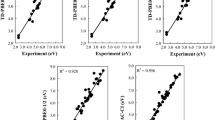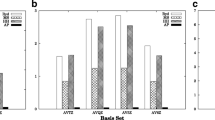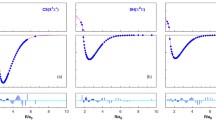Summary
A new one-particle zeroth-order Hamiltonian is proposed for perturbation theory with a complete active space self-consistent field (CASSCF) reference function. With the new partitioning of the Hamiltonian, reference functions dominated by a closed-shell configuration, on one hand, and an open-shell configuration, on the other hand, are treated in similar and balanced ways. This leads to a better description of excitation energies and dissociation energies. The new zeroth-order Hamiltonian has been tested on CH2, SiH2, NH2, CH3, N2, NO, and O2, for which full configuration interaction (FCI) results are available. Further, excitation energies and dissociation energies for the N2 molecule have been compared to corresponding multireference (MR) CI results. Finally, the dissociation energies for a large number of benchmark molecules containing first-row atoms (the “G1” test) have been compared to experimental data. The computed excitation energies compare very well with the corresponding FCI and MRCI values. In most cases the errors are well below 1 kcal/mol. The dissociation energies, on the other hand, are in general improved in the new treatment but have a tendency to be overestimated when compared to other more accurate methods.
Similar content being viewed by others
References
Kelly HP (1963) Phys Rev 131:684
Andersson K, Blomberg MRA, Fülscher MP, Kellö V, Lindh R, Malmqvist P-Å, Noga J, Olsen J, Roos BO, Sadlej AJ, Siegbahn PEM, Urban M, Widmark P-O (1992) MOLCAS Version 2 User's Guide. Dept. of Theor. Chem., Chem. Center, Univ. of Lund, Lund
Møller C, Plesset MS (1934) Phys Rev 46:618
Murray C, Davidson ER (1992) Int J Quantum Chem 43:755
Knowles PJ, Andrews JS, Amos RD, Handy NC, Pople JA (1991) Chem Phys Lett 186:130
Murray C, Davidson ER (1991) Chem Phys Lett 187:451
Lee TJ, Jayatilaka D (1993) Chem Phys Lett 201:1
Murray CW, Handy NC (1992) J Chem Phys 97:6509
Roos BO (1987) The complete active space self-consistent field method and its applications in electronic structure calculations. In: Lawley KP (ed) Advances in chemical physics; ab initio methods in quantum chemistry — II, ch 69. John Wiley, Chichester, England, p 399
Roos BO, Linse P, Siegbahn PEM, Blomberg MRA (1982) Chem Phys 66:197
Andersson K, Malmqvist P-Å, Roos BO, Sadlej AJ, Wolinski K (1990) J Phys Chem 94:5483
Andersson K, Malmqvist P-Å, Roos BO (1992) J Chem Phys 96:1218
Andersson K, Roos BO (1994) Multiconfigurational second-order perturbation theory. In: Yarkony DR (ed) Modern electronic structure theory, Vol 1. World Scientific Publishing, New York
Roos BO, Fülscher MP, Malmqvist P-Å, Serrano-Andrés P-L, Merchán M (1994) Theoretical studies of the electronic spectra of organic molecules. In: Langhoff Stephen R (ed) Quantum mechanical electronic structure calculations with chemical accuracy. Kluwer, Dordrecht, Netherlands.
Andersson K, Roos BO, (1993) Int J Quantum Chem 45:591
Bauschlicher Jr CW, Taylor PR (1986) J Chem Phys 85:6510
Kozlowski PM, Davidson ER (1994) J Chem Phys 100:3672
Bauschlicher Jr CW, Taylor PR (1987) J Chem Phys 86:1420
Bauschlicher Jr CW, Langhoff SR, Taylor PR, Handy NC, Knowles PJ (1986) J Chem Phys 85:1469
Bauschlicher Jr CW, Taylor PR, (1987) J Chem Phys 86:5600
Bauschlicher Jr CW, Langhoff SR (1987) J Chem Phys 86:5595
Werner HJ, Knowles PJ (1991) J Chem Phys 94:1264
Almlöf J, DeLeeuw BJ, Taylor PR, Bauschlicher Jr CW, Siegbahn P (1989) Int J Quantum Chem: Quantum Chem Symp 23:345
Pople JA, Head-Gordon M, Fox DJ, Raghavachari K, Curtiss LA (1989) J Chem Phys 90:5622
Andersson K, Roos BO, Malmqvist P-Å, Widmark P-O to be published.
Huber KP, Herzberg G (1979) Constants of diatomic molecules. In: Molecular Spectra and Molecular Structure, Vol. IV. Van Nostrand Reinhold, New York
Author information
Authors and Affiliations
Rights and permissions
About this article
Cite this article
Andersson, K. Different forms of the zeroth-order Hamiltonian in second-order perturbation theory with a complete active space self-consistent field reference function. Theoret. Chim. Acta 91, 31–46 (1995). https://doi.org/10.1007/BF01113860
Received:
Revised:
Accepted:
Issue Date:
DOI: https://doi.org/10.1007/BF01113860




